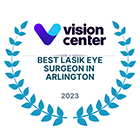Advanced Keratoconus Treatment. Experienced Care. Silk Vision & Surgical Center
What Is Keratoconus?
The cornea is the window of the eye. Light travels through the cornea past the lens to the retina and then the brain to form a visual image. The normal corneal surface is smooth and aspheric i.e. round in the center, flattening towards its outer edges. Light rays passing through it moves in an undistorted manner to the retina to project a clear image to the brain.
Keratoconus is a disorder in which the cornea undergoes progressive thinning and is the most common corneal dystrophy in the U.S., affecting one in every 2000 Americans. It is more prevalent in teenagers and adults in their 20s. Keratoconus arises when the middle of the cornea thins and gradually bulges outward, forming a rounded cone shape. This abnormal curvature changes the cornea's refractive power, producing moderate to severe distortion (astigmatism) and blurriness (nearsightedness) of vision. Keratoconus may also cause swelling and a sight-impairing scarring of the tissue.
Studies indicate that keratoconus stems from one of several possible causes:
- An inherited corneal abnormality. About seven percent of those with the condition have a family history of keratoconus
- An eye injury, i.e., excessive eye rubbing or wearing hard contact lenses for many years. Certain eye diseases, such as retinitis pigmentosa, retinopathy of prematurity, and vernal keratoconjunctivitis.
- Systemic diseases, such as Leber's congenital amaurosis, Ehlers-Danlos syndrome, Down syndrome, and osteogenesis imperfecta.
How Is It Treated
Keratoconus usually affects both eyes. At first, people can correct their vision with eyeglasses. But as the astigmatism worsens, they must rely on specially fitted contact lenses to reduce the distortion and provide better vision. Although finding a comfortable contact lens can be an extremely frustrating and difficult process, it is crucial because a poorly fitting lens could further damage the cornea and make wearing a contact lens intolerable. In most cases, the cornea will stabilize after a few years without ever causing severe vision problems. But in about 10 to 20 percent of people with keratoconus, the cornea will eventually become too scarred to tolerate a contact lens. At this point surgery may be needed to restore vision. In the past surgical treatment options were limited and often required long periods of time to recover vision.
Now, however, there are new treatment options for patients such as collagen crosslinking with ultraviolent light, INTAC corneal implants, and advanced corneal transplantation techniques such deep anterior lamellar keratoplasty (DALK). These new procedures are less invasive and have faster visual recovery times.
Collagen Cross Linking
It is estimated that eventually 21% of the keratoconus patients require surgical intervention to restore corneal anatomy and eyesight. A new non surgical, non invasive treatment, based on collagen cross linking with Ultraviolet A (UVA, 365nm) and riboflavin (Vitamin B 2), a photosensitizing agent is now available. This changes the structural properties of the cornea, increasing its strength by almost 300%. This increase in corneal strength has shown to stop the progression of keratoconus in numerous studies all over the world.
What is collagen cross-linking?
A new treatment for keratoconus which has shown great success is Corneal Collagen Crosslinking with Riboflavin, a one-time application of riboflavin eye drops to the eye. It's a new procedure for Keratoconus which uses Riboflavin eye drops in conjunction with UV lights to strength the cornea; this procedure has shown great success in reducing the progression of keratoconus. The riboflavin, when activated by approximately 30 minutes illumination with UV-A light, augments the collagen within the stroma thus recovering some of the cornea's mechanical strength. This technique was developed at the Technische University Dresden in Germany and has been shown to slow or arrest the progression of keratoconus, and in some cases even reverse it, particularly when applied in combination with intracorneal ring segments.
Intacs
How do Intacs work and how might they help me?
Due to the onset and progression of keratoconus, the weakened cornea loses its natural dome-like shape. As a result, the light rays entering the eye are no longer focused properly, impairing one’s ability to see images clearly. Intacs are specially designed inserts, made of medical plastic, which are surgically placed under the surface of the cornea. Due to their unique patented design, Intacs are able to remodel the structure of the cornea re-establishing a more natural dome-like shape and improving one’s vision.


Why Silk Vision & Surgical Center?
Dr. Silk is a board certified eye physician and surgeon. He received his medical degree from Marshall University and his ophthalmic training from the Virginia Commonwealth University/Medical College of Virginia. He completed a fellowship in Corneal Diseases and Advanced Cataract Surgery with some of the nation’s leading experts at the University of Pittsburgh, which is annually ranked as one of the leading hospitals in the nation by the U.S. News & World Report.
Dr. Silk is a Fellow of the American Academy of Ophthalmology, American Society of Cataract & Refractive Surgery, The Cornea Society, and is active in clinical research. Dr. Silk welcomes new patients for surgical eye care.
Dr. Silk was one of the principle investigators and participated in the FDA clinical trials for corneal cross linking with the Avedro system and has lectured on this procedure extensively.
Dr. Silk was also one of the first surgeons in the area to perform Intac surgery to help reshape the cornea for patients with keratoconus.
He has been performing both corneal collagen cross linking and Intac surgery since 2013 and has done several hundreds of cases.










.png)
